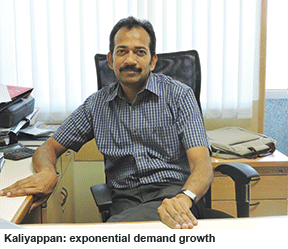Top-ranked corporates such as TCS, Wipro, Infosys, among others are investing heavily in developing embedded systems and rapidly expanding operations Indra Gidwani
 India is slated as the next embedded systems hub of the world. A recent (2015) McKinsey World Institute-NASSCOM survey predicts that jobs in the embedded systems domain will increase tenfold from the current 60,000 professionals to over 100,000 by 2016.
India is slated as the next embedded systems hub of the world. A recent (2015) McKinsey World Institute-NASSCOM survey predicts that jobs in the embedded systems domain will increase tenfold from the current 60,000 professionals to over 100,000 by 2016.
An embedded system is an in-built computer for specific usage or limited functions and distinguished from a general purpose computer which can perform a variety of tasks. For instance, an embedded system in an elevator directs its motor to move to and stop at different floors. A decoder embedded in a satellite television set-top box reads signals to and from a satellite dish to a television set. Similarly, embedded systems are designed, developed and installed for specific purposes in homes, offices, automobiles, spacecraft, defence equipment and a multiplying number of products and processes.
Study programmes
Embedded engineering professionals are typically equipped with BE/B. Tech/MCA and/or M.Sc (physics) degrees. An embedded engineer is usually an all-rounder with a broad set of educational qualifications specialising in one of two domains: hardware or software.
Professionally qualified engineers design and develop printed circuit boards, module prototypes, and develop and test embedded systems. To qualify as an embedded software developer, engineering/science graduates need embedded C, C++, Java and HTML program certification, and knowledge of real time operating systems such as embedded NT, Windows CE, Vx Works and RT Linux and assembly, microprocessor/controller architecture, driver design, middleware, embedded applications etc. Top-ranked corporates such as TCS, Wipro, L&T, Tata Elxsi, Infosys, Zensat, Tech Mahindra, Patni, etc are investing heavily in developing embedded systems and rapidly expanding operations in India.
Remuneration prospects
Remuneration packages vary according to skill-sets and qualifications. An engineer with a bachelor’s degree can expect a starting pay package of Rs.3-15 lakh per annum depending on the size of the recruiter organisation and the domain (product development or services provider). Professionals with M.Tech or a Ph D can negotiate considerably higher salaries.
“There’s been nearly a three-fold increase in the size of the embedded systems market in India from US $4.95 billion in 2009 to $14.4 billion (Rs.89,280 crore) this year, according to Nasscom, and the demand for qualified professionals is also growing exponentially. However, there’s a tremendous dearth of skilled embedded engineers that has to be addressed by specialised training provided by companies obliged to recruit mint-fresh engineers,” says Selvaraj Kaliyappan, vice-president, engineering of the Bangalore-based Mistral Solutions Pvt. Ltd, a technology design and systems engineering company providing end-to-end solutions for product design and applications deployment. Promoted in 1998, Mistral Solutions has established regional offices in Delhi and Hyderabad, and a subsidiary — Mishal Solutions Inc — in Santa Clara, USA.
Professional profile
With over 23 years of experience in the field of electronics hardware design and product development, Kaliyappan — an electronics and communication graduate of the Mookambigai Engineering College, Trichy (affiliated with Bharathidasan University, Coimbatore) — started his career in 1992 as a field application engineer with Digipro Systems Pvt. Ltd, served as a senior designer at Cranes Infotech before signing up with Mistral Solutions in 1998.
For India to emerge as the embedded systems design and innovation hub, Kaliyappan believes it’s necessary to proactively address the needs of the market by building partnerships between industry, academia and start-ups. “This can be done by making education and vocational training demand and market driven. We need to supplement college education with employment-oriented courses. Education and vocational training also needs to be aligned with industry needs and demand,” he says.
Optimistic about the future of India’s IT and infotech industries, Kaliyappan believes the proliferation of intelligent devices and Internet of Things has generated a huge and pressing demand for innovative solutions. “21st century solutions require high quality embedded engineering education to produce creative engineers prepared to take risks. The unstoppable demand for smarter connectivity devices will continue to grow. Therefore for well qualified, creative, experienced embedded system specialists, the future is very bright,” says Kaliyappan.
Right on!























